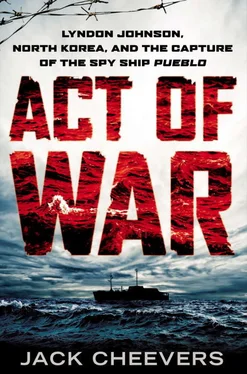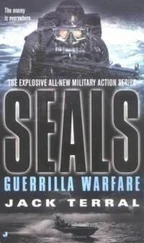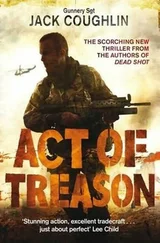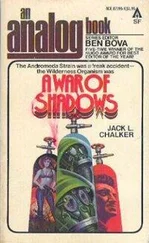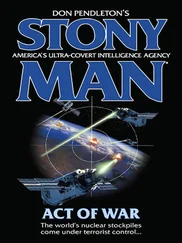Freezing air stung their lungs, but they made progress. Bucher joined in the chipping and, when the job was finished, goaded his men into a snowball fight. That evening, he made sure each member of the deicing party had a small bottle of brandy to warm up with.
After two days of surveillance, the intelligence take from Chongjin was negligible. Disappointed, Bucher headed south for his next stop, the port of Songjin. He kept the ship 13 to 16 miles from shore during daylight, and withdrew at night to 25 to 30 miles. The captain instructed Law to crosshatch the navigation charts with a red pencil to the west of the 13-mile barrier, and to draw a thick blue line at 14 miles from shore. Navigators were under orders to call Bucher to the bridge if they even approached the blue mark.
On the morning of January 19, the spy boat was 15 miles east of Songjin. Frustrated CTs were acquiring precious little data. They’d pick up an electronic signal and, after the ship traveled a bit farther, pick it up again. In theory, recording the same signal from two different angles pinpointed the sending station. On a chart, two lines were drawn toward the signal from the two points at which it was detected; the lines’ intersection indicated the signal’s point of origin. But the SOD hut receivers weren’t accurate and most of the lines didn’t cross. In cases where they did, the sending station was invariably marked on the charts already. Boredom again blossomed among the CTs.
The Pueblo drifted farther south. Steve Harris confided to Murphy that North Korean fire-control radar had locked on the ship. The XO knew that didn’t necessarily mean the Pueblo was in danger. But it was a little disconcerting that the communists were tracking them.
Bucher still hoped to photograph a North Korean submarine in the vicinity of Mayang-do. Such a coup would make the whole mission worthwhile. But no subs appeared, heightening the commander’s sense that he was wasting his time. He wrote in a report that the voyage to date had been “unproductive.” Schumacher wryly concluded that he’d learned an important lesson about the North Koreans: Unlike the half-frozen crew of the Pueblo , they knew better than to wander about the Sea of Japan in the dead of winter.
While the CTs’ annoyance grew, the two civilian oceanographers were quite pleased with the way their work was going.
Dunnie Tuck and Harry Iredale were a study in contrasts. Tuck, who’d served on the Banner the previous summer during trips to the USSR and China, was an almost maniacally gregarious Virginia native. Balding at 30, he was a funny, storytelling charmer who boasted of many romantic conquests. His nickname was, of course, Friar. His 24-year-old sidekick, Iredale, a bright, bespectacled former Penn State math major, was shy and fidgety, painfully aware of his short stature, and luckless at bedding women. He, too, had served briefly aboard the Banner .
Twice a day, the two men walked to the well deck and dropped over the side a dozen yellow Nansen bottles attached at intervals to a long wire. Later they winched the heavy brass canisters back up and tested the water samples from different depths for salinity, sound conductivity, and temperature. The measurements provided the veneer of peaceful research, but they had important military applications as well, particularly in submarine operations.
The Pueblo arrived off Wonsan early on the morning of January 22.
Besides having a busy harbor, the city served as a major railroad hub that American warships had shelled repeatedly during the Korean War. It was well defended by antiaircraft batteries and dozens of MiG fighters. In the SOD hut, the CTs finally began to get some interesting signals.
Shortly after lunch Gene Lacy called from the bridge to report two North Korean trawlers approaching. The captain hurried up for a look. He ordered Schumacher to join him and the CTs to tune in on the trawlers’ communications. The rest of the crew picked up on the ripple of activity; seamen rushed up to the main deck to watch the action.
Both boats carried nets and other fishing gear and appeared to be unarmed. Their smokestacks were emblazoned with a red star inside a white circle.
The trawlers began slowly circling the Pueblo from about five hundred yards away. Their crewmen all seemed to be on deck, pointing and talking excitedly. Suddenly one of the vessels changed course and charged toward the spy ship, veering off when it was just one hundred yards away.
Some Pueblo sailors raised their middle fingers at the passing North Koreans. Bucher ordered everyone below, hoping the communists wouldn’t wonder why so many men were on such a small boat. The two trawler captains then withdrew several miles and pulled close together, as if conferring. At about two p.m., they headed back toward the Pueblo . Fearing a ramming, Bucher fired up his engines. The trawlers steamed to within twenty-five yards and began circling again, their crews taking photographs. The communists’ faces were clearly visible and, as one Pueblo sailor noted, “They looked like they wanted to eat our livers.”
Bucher called one of the Marine translators, Bob Chicca, to the bridge to decipher the trawlers’ names. Armed with a Korean dictionary, Chicca gazed intently at the vessels.
“One of them is Rice Paddy and the other is Rice Paddy One , Captain,” he said.
Bucher still was observing emission control, but he figured the Pueblo —with “GER-2” painted on its hull in large white letters—had definitely been identified this time. At three p.m. both trawlers withdrew to the northeast. The captain began to prepare a situation report, or SITREP in Navy jargon, to inform COMNAVFORJAPAN of what had happened.
By about five p.m., the narrative was ready and a radioman opened a circuit to Kamiseya.
———
The North Korean commando stared through his field glasses at the big city spread out below him. He hadn’t expected Seoul to look so beautiful and prosperous.
The morning mist had lifted on Pibong Hill, north of the South Korean capital, where Second Lieutenant Kim Shin-jo and his thirty fellow guerrillas lay hidden. From the hillside they could see their target: the South Korean presidential mansion, known as the Blue House. Come nightfall, the infiltrators planned to shoot their way into the building and cut off the head of South Korea’s iron-fisted president, Park Chung Hee. Then they’d kill his family and staff, steal vehicles from the presidential motor pool, and escape.
It was Sunday, January 21.
Kim and his comrades were officers in North Korea’s highly trained 124th Army Unit, which specialized in unconventional warfare and political subversion. For two years they’d practiced behind-the-lines fighting as part of North Korean dictator Kim Il Sung’s ruthless scheme to foment revolution in South Korea and reunify the peninsula by force. The communists hoped President Park’s assassination would create political chaos in the south, giving North Korean troops a pretext to march in and “stabilize” the country.
The members of Lieutenant Kim’s platoon were in superb physical condition and armed to the teeth. Their ages ranged from 24 to 28. With leg muscles hardened by running with several pounds of sand sewn into their trouser cuffs, the men could cover a herculean six miles of rugged terrain an hour with sixty pounds of equipment on their backs. Each officer carried a Russian-made submachine gun, a semiautomatic pistol, three hundred rounds of ammunition, eight antipersonnel grenades, and an antitank grenade. If their guns jammed, they’d fight with their bare hands and feet, every man having mastered judo and karate.
Читать дальше
